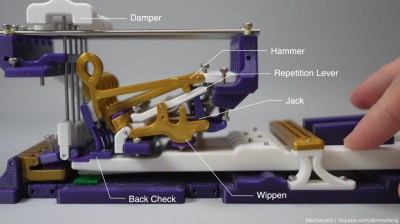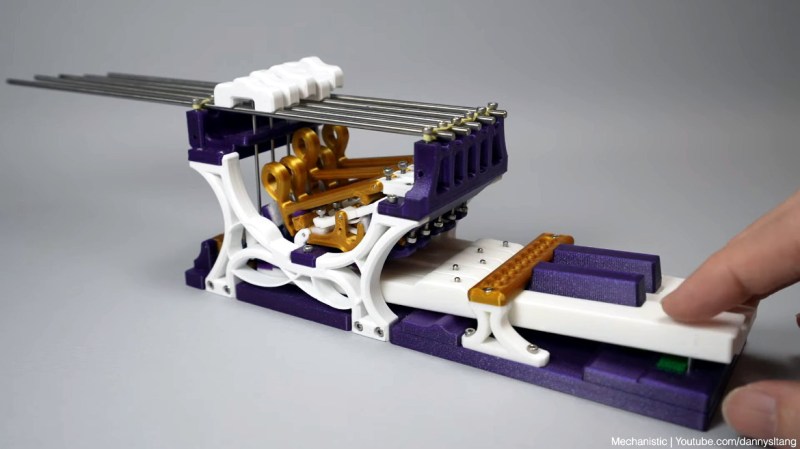Do you know how a piano works? Sure, you press a key and a hammer strikes a string, but what are the finer points of this operation? The intricacy of the ingenious mechanism is laid bare in [Mechanistic]’s 3D-printed scale model of a small section of the grand piano keyboard. The ‘grand’ distinction here is piano length-agnostic and simply refers to any non-upright. Those operate the same way, but are laid out differently in order to save space.
 The keys of an acoustic piano are much longer than just the part that shows — they are long levers that do a lot of work, including working their own sound dampeners. The really interesting part is the mechanism that allows a note to be played repeatedly without first releasing the key. This same mechanism also lets the pianist play softly, loudly, or somewhere in between based on the amount of pressure applied.
The keys of an acoustic piano are much longer than just the part that shows — they are long levers that do a lot of work, including working their own sound dampeners. The really interesting part is the mechanism that allows a note to be played repeatedly without first releasing the key. This same mechanism also lets the pianist play softly, loudly, or somewhere in between based on the amount of pressure applied.
So you know that the hammer strikes the string (or in this case, the rod), and you can probably figure that it backs off to let the string ring out. But there’s also this whole system that keeps the hammer close by for repeated strikings, as long as the person is holding down the key. Be sure to check it out in the build video after the break.
[Mechanistic] must be going for the standing ovation, because they say in the video’s comments that they will release STL files when they’re finished writing the assembly guide (!). What an encore that will be.
There are many ways to hack an acoustic piano, but don’t go thinking you can sub in guitar strings.
















That gets you most of the way here: https://www.youtube.com/watch?v=X-pGytcPQ08
This is crazy good design and fabrication. Congratulations on an awesome demo of how pianos work. They are one of the coolest mechanical devices and this build shows it really well.
Having a few of those actual maker’s demo displays about, I could only point to the use of plastics for poor action manufacture. These are made of maple or box wood, maybe pear. Not a 100 year plus experiment in plastic’s lifespan for you.
Hooray for the repetition lever, there is one upright action that has them too.
Such great attention to detail on the escapement mechanism, and then such poor execution on the acoustic part: a) no soundboard, b) dampers (no, not “dampeners”) don’t actually mute them, c) poor resonators (bars don’t ring, and in particular not at the frequency they’re tuned to, d) all bars have the same distance between the bridge and the nut. Not ideal. Most super-cheap keyboard glockenspiels sound better than this – it would have made more sense to start with a glockenspiel and have the hammers hit the bars on that. Or at least take some measurements off of one. It’s true, kiddie glockenspiels don’t have soundboards, but the flat side of each bar acts as its own soundboard. A piece of wire is very poor at this. ‘Course, you could put reluctance pickups on it, which might help, but the other issues would still be there.
Replace the bars with Rhodes tuning forks. Then presto, world’s smallest electric piano.
heh yeah it’s the fact that they did such a good job on it that makes it disappointing that there’s no attempt to actually make it a working instrument. my first thought was “that’ll work a lot better if you use felt on the parts that need felt” before i realized it wasn’t actually supposed to go in a real piano.
but it is what it is, as a movable model to try to understand how it works i bet it’s fantastic. i’ve tried to figure these things out from looking in a working piano and it’s possible but it’s a lot harder to tell what’s going on when they’re packed together like that, and this demo is even clearer than playing with an aciton that has been removed from the piano, because there is still a “string”
Wow. awsome work!
In the “Deutsche Museum” in Munich they have a collection of all the different kinds of piano mechanics. Very good to see, how it all developed to the current version(s). (And how different the mechanics in a Harpsichord are compared to the piano)
I’d really like to see a 3D printed teleprinter some day. Might try it if I ever get some of that elusive “free time.”
Little complicated though, so it might be easier to start with something like a stock ticker-tape or a daisy wheel printer.
Learn from Lindner’s mistakes if you ever go further with this…